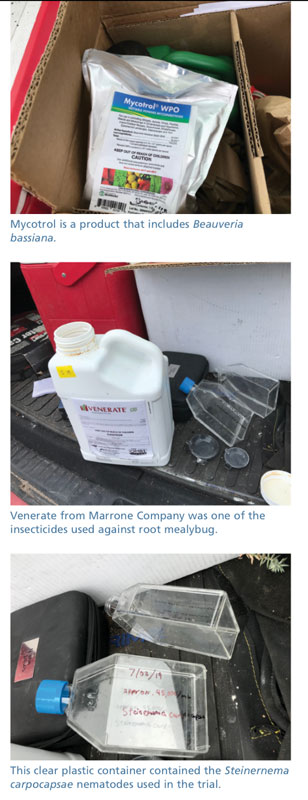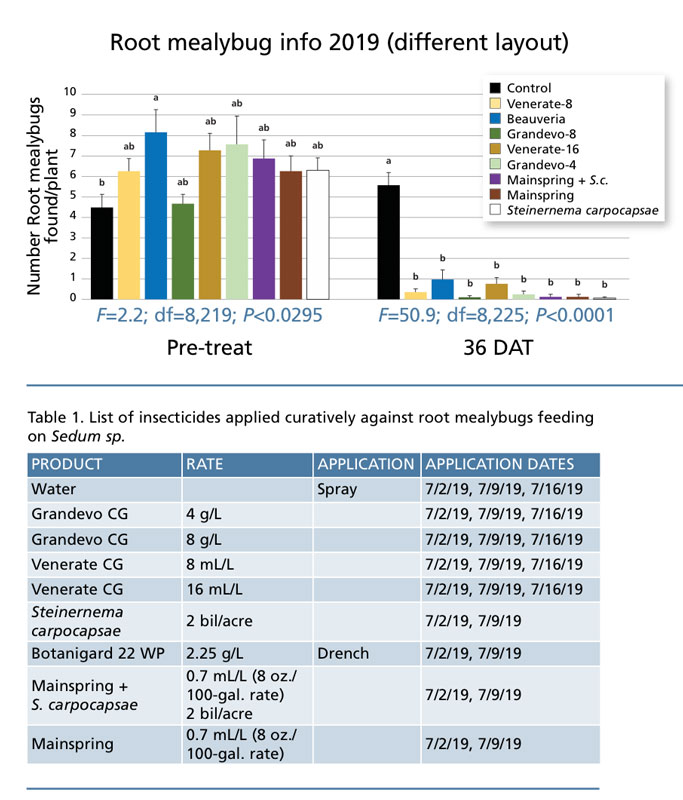5/1/2020
Root Mealybug, Part 2
Stanton Gill, Brian Kunkel, Chuck Schuster, Ginny Rosenkranz & Suzanne Klick

In 2018, we started down the road of looking at root mealybug control options and published the results in GrowerTalks in April of 2019. In the 2019 growing season, we had the opportunity to expand the number of materials we tested for this insect, working with several national
companies.
Root mealybug appears to be a rising problem in herbaceous perennial nurseries, aquatic plant nurseries, and greenhouses growing field hemp stock and plug plants for transplanting for the rapidly expanding number of field hemp growers. In herbaceous perennial nurseries, root mealybug is a difficult-to-control problem on asters and solidago.
Growers often concentrate on examining the growth above the substrate level. Often, customers are the ones who notice there are bugs on the root system and give less-than-complimentary feedback to the grower. Even though these insects are out of sight, they’re feeding on the roots of the plants resulting in reduced growth. Once they’re established in a greenhouse, they can easily spread to adjacent plants, often completely unseen by the growers. They move from flat to flat and from bench to bench.
As growers, you may notice the plant is stunted and not growing well until you take the plant out of the pot and look at the root system, then the wax associated with root mealybug becomes noticeable. If the population builds up, your customer will definitely notice a problem when they go to take the pot off and plant the infested plant. The wax is very noticeable on the roots on the outside perimeter of the rootball.
We initiated the first field trials in 2018 and received lots of feedback from growers in other states. We decided to follow up with a second set of trials in 2019, increasing the number of products we evaluated and looking at biological control options in this expanded effort. We initially selected this pest because it’s tough to control and several growers reported it was becoming an economic factor for their operations. We were able to locate a heathy root mealybug population in a working nursery setting.
Types of root mealybugs
There are two major root mealybugs found on nursery and landscape plants in North America. One called ground mealybug, Rhizoecus falcifera; the second is called Pritchard’s mealybug, Rhizoecus pritchardi. Both are in the order Hemiptera, family Psuedococcidae.
The ground mealybug is white and 2.4 to 3.9 millimeters long and has slender waxy filaments that form a sort of netting over some individuals. The ground mealybug also secretes a small amount of wax, which can give the soil a somewhat bluish appearance when the mealybugs are abundant. Pritchard's mealybug is smaller than the ground mealybug, is snow white and 1.6 to 2.1 millimeters long and oval with very small eyes. The wax from Pritchard’s mealybug tends to be snow white in color. In our study, the Pritchard mealybug was the one present on sedum roots.
The ground mealybug is reported to feed on the roots of anemone, chrysanthemum, gladiolus, iris and numerous other flowers, shrubs and ornamental grasses. Pritchard’s mealybug is a pest of achillea, arctostaphylos, asters, geum, polygala and sedums.
Dr. Arnold H. Hara of the University of Hawaii-Manoa reported pest management guidelines in 2010 that currently the Hawaiian Islands have seven species of root or hypogaeic mealybugs. The most pestiferous species have been the coffee root mealybug, Geococcus coffeae and Rhizoecus hibisci. These root mealybugs infest grasses, palms, citrus, cyperus, pineapple, coffee, mango and syngonium. In pots, root mealybugs occur throughout the root mass; however, they’re concentrated between the root ball and the pot. Infestation of root mealybugs is noticeable only if the root ball is removed from the pot.
Succulent plants appear to be increasing in popularity, often being used in hot, dry landscapes, in ornamental containers and in green roofs plantings. A number of cities have encouraged installation of green roofs to reduce energy use and clean up roof runoff water in city environments. Of course, there’s the aesthetic aspect that goes along with green roofs; now people are adding the benefits to pollinators and birds with green roof installation. The number of nurseries growing sedum species of plants to be installed in these green roofs and succulents for hot dry areas in landscapes is growing.
 Very little is published on the lifecycle of either root mealybug species. Arnold Hara reports female mealybugs lay eggs or give birth to live, young crawlers. If eggs are laid, they usually hatch in less than 24 hours. Crawlers are the dispersal stage and are highly mobile. Once the crawlers find a suitable site, they settle down and begin to feed on roots with their sucking mouthparts. The entire life cycle ranges from two to four months, depending on the species. Adults live from 27 to 57 days, also depending on the species.
Very little is published on the lifecycle of either root mealybug species. Arnold Hara reports female mealybugs lay eggs or give birth to live, young crawlers. If eggs are laid, they usually hatch in less than 24 hours. Crawlers are the dispersal stage and are highly mobile. Once the crawlers find a suitable site, they settle down and begin to feed on roots with their sucking mouthparts. The entire life cycle ranges from two to four months, depending on the species. Adults live from 27 to 57 days, also depending on the species.
Pritchard’s mealybugs has been noted to crawl out of drainage holes and spread throughout the nursery or greenhouse. In nurseries, we’ve found Pritchard’s mealybugs moving between pots of asters that were sitting on spun-down polypropylene weed barrier. In green roof plant nurseries, we noted the Pritchard’s mealybug moving from plug trays sitting on weed barrier on the ground to previously uninfested plant trays close to infested plants.
Trials in 2019
We worked with a green roof plant nursery that had sedums infested with both root aphid and root mealybugs. For this study, we concentrated on the root mealybug—Pritchard’s mealybug—in evaluating several new classes of systemic chemicals, entomopathogenic nematodes and entomopathogenic fungi, all applied as soil drenches.
In this second year (2019) of the trials, we added applications of two products from Marrone Company, entomopathogenic nematodes and Beauveria bassiana soil drenches, along with two products we tested in 2018.
Applications were made to plants with known infestations. Pre-counts establish the number of root mealybugs present in each plug. Post treatment evaluation involved taking counts of living root mealybug at set times after the treatments. Two of the products, Grandevo CG and Venerate CG, were applied on a weekly basis until a week before the final counts were taken. This was upon request of the Marrone technical representative. In the trial, we had eight completely randomized blocks.
Summary
Mainspring from Syngenta did well in our first year of trials in 2018 and continued its good performance in 2019. The combination of Mainspring and entomopathogenic nematodes (Steinernema carpocapsae) gave equal levels of control to each of these material when applied alone. All of these treatments were significantly better than the untreated control. The Beauveria bassiana and Venerate at the 16 treatment gave pretty much equal control. Grandevo at both rates gave control equal to Mainspring. GT
Stanton Gill is Extension Specialist in IPM for Greenhouses and Nursery for the Central Maryland Research and Education Center at the University of Maryland Extension (Extension.umd.edu/ipm), and a professor at Montgomery College. He can be reached at Sgill@umd.edu or (410) 868-9400. Brian Kunkel is an Extension Ornamental IPM Specialist at the University of Delaware Cooperative Extension. He can be reached at bakunkel@udel.edu or (302) 893-6077. Chuck Schuster is an Extension Educator at the University of Maryland Extension. He can be reached at CFS@umd.edu. Ginny Rosenkranz is an Extension Educator for the University of Maryland Extension. Suzanne Klick is Lead technician at the Central Maryland Research and Education Center for the University of Maryland, and a Student Intern at the University of Delaware.